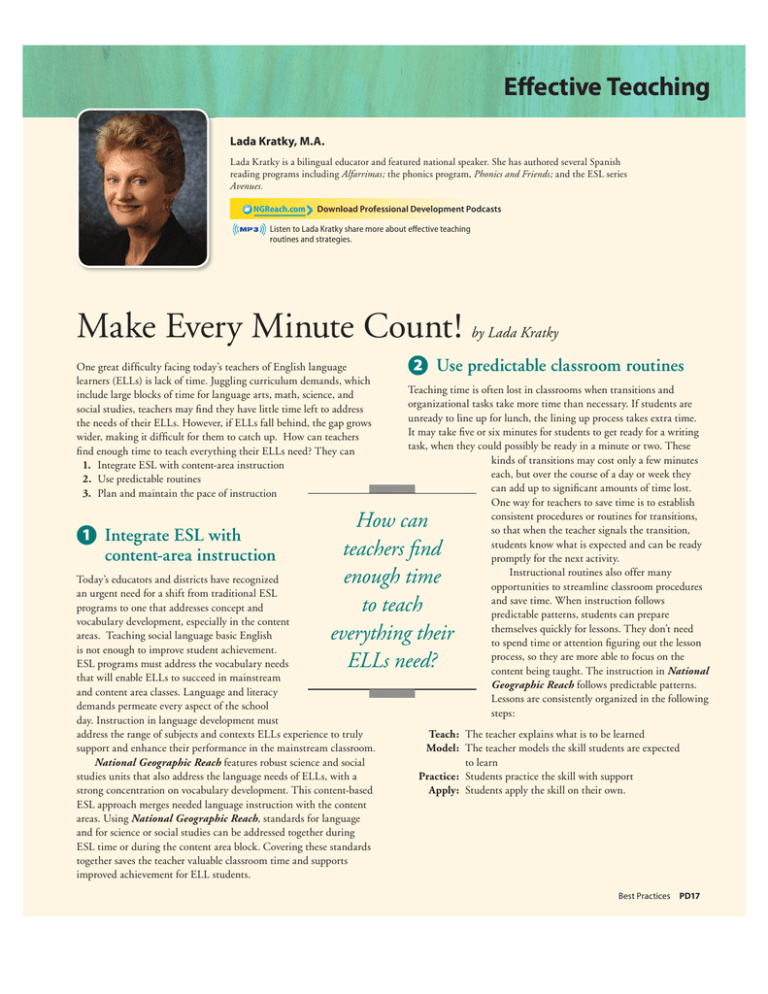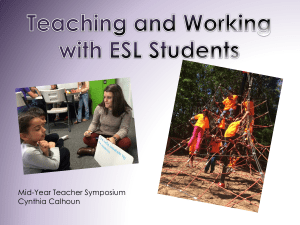Make Every Minute Count! by Lada Kratky
advertisement

Effective Teaching Lada Kratky, M.A. Lada Kratky is a bilingual educator and featured national speaker. She has authored several Spanish reading programs including Alfarrimas; the phonics program, Phonics and Friends; and the ESL series Avenues. NGReach.com Download Professional Development Podcasts Listen to Lada Kratky share more about effective teaching routines and strategies. Make Every Minute Count! by Lada Kratky One great difficulty facing today’s teachers of English language learners (ELLs) is lack of time. Juggling curriculum demands, which include large blocks of time for language arts, math, science, and social studies, teachers may find they have little time left to address the needs of their ELLs. However, if ELLs fall behind, the gap grows wider, making it difficult for them to catch up. How can teachers find enough time to teach everything their ELLs need? They can 1. Integrate ESL with content-area instruction 2. Use predictable routines 3. Plan and maintain the pace of instruction 1 Integrate ESL with content-area instruction 2 Use predictable classroom routines Teaching time is often lost in classrooms when transitions and organizational tasks take more time than necessary. If students are unready to line up for lunch, the lining up process takes extra time. It may take five or six minutes for students to get ready for a writing task, when they could possibly be ready in a minute or two. These kinds of transitions may cost only a few minutes each, but over the course of a day or week they can add up to significant amounts of time lost. One way for teachers to save time is to establish consistent procedures or routines for transitions, so that when the teacher signals the transition, students know what is expected and can be ready promptly for the next activity. Instructional routines also offer many opportunities to streamline classroom procedures and save time. When instruction follows predictable patterns, students can prepare themselves quickly for lessons. They don’t need to spend time or attention figuring out the lesson process, so they are more able to focus on the content being taught. The instruction in National Geographic Reach follows predictable patterns. Lessons are consistently organized in the following steps: How can teachers find enough time to teach everything their ELLs need? Today’s educators and districts have recognized an urgent need for a shift from traditional ESL programs to one that addresses concept and vocabulary development, especially in the content areas. Teaching social language basic English is not enough to improve student achievement. ESL programs must address the vocabulary needs that will enable ELLs to succeed in mainstream and content area classes. Language and literacy demands permeate every aspect of the school day. Instruction in language development must address the range of subjects and contexts ELLs experience to truly support and enhance their performance in the mainstream classroom. National Geographic Reach features robust science and social studies units that also address the language needs of ELLs, with a strong concentration on vocabulary development. This content-based ESL approach merges needed language instruction with the content areas. Using National Geographic Reach, standards for language and for science or social studies can be addressed together during ESL time or during the content area block. Covering these standards together saves the teacher valuable classroom time and supports improved achievement for ELL students. Teach: The teacher explains what is to be learned Model: The teacher models the skill students are expected to learn Practice: Students practice the skill with support Apply: Students apply the skill on their own. Best Practices PD17 National Geographic Reach also makes extensive use of instructional routines. These are simple learning procedures that follow a series of regular steps. Vocabulary, for example, is taught using a series of specific routines on successive days of the lesson cycle. As noted, National Geographic Reach emphasizes academic and content vocabulary. This focus implies a natural shift in methodology. It is no longer enough for students to simply hear the word followed by its definition and then use it in a sentence. Vocabulary instruction includes introducing the words, expanding word knowledge, sharing word knowledge, reteaching vocabulary, and providing additional vocabulary experiences. Part 1 Vocabulary Skills Trace Day 1 Day 2 Day 3 Day 4 Day 5 Day 6 Day 7 Days 8–9 Day 10 Social Studies Vocabulary Academic Vocabulary Expand Word Knowledge Share Word Knowledge Apply Word Knowledge Multiple-Meaning Words Multiple-Meaning Words Extend Vocabulary Vocabulary Review Page T5 T7 T10b T24b T25b T26 T31 T32e–f T32h Vocabulary instruction makes use of a consistent set of research-based routines. s Introduce the words To introduce a word, the teacher pronounces it and points to a picture or diagram that depicts it. Immediately, students are asked to react to the word by rating it; they show if they know the word well, a little, or not at all, by showing one, two, or three fingers. They then share what they know about it. The teacher will give students a friendly definition of the word and use the picture dictionary to further illustrate the word. He/she then further elaborates the meaning of the word, relating it to personal experience, and encouraging the students to share their own experience. The students are motivated through questions or comments to discuss the word. This discussion will help students understand the word and its uses even further. In addition, the word will be analyzed by pointing out its parts and spelling patterns that will help the students recognize the word. Finally, the students can connect the word to other content areas, and the teacher can put it up on the Word Wall. s Expand word knowledge On the next day, the students expand their word knowledge through the use of discussion, graphic organizers, drawing, and writing. The students are grouped in pairs, and each pair will become an expert on one word. The teacher then shows how to complete a graphic organizer. The graphic organizer is displayed, the teacher writes the word, adds a picture, definition, and content sentence. Each pair of students then completes the task using their Key Word and a similar graphic organizer. Becoming an expert builds depth of word knowledge, enhances wordlearning strategies, and builds confidence and collaboration. PD18 Make Every Minute Count! s Share word knowledge On the following day, students share their knowledge of the word they have been studying. Each students is paired with a partner who has been working on a different word than their own. They take turns reading to each other from their Graphic Organizers. As partners, they proceed to discuss and write sentence using both words they are studying. They write the sentences in their journal and underline the Key Words. The teacher forms cooperative learning groups and the activity is repeated until each Key Word has been entered into the students’ journals. Once again, the activity provides opportunities for academic talk, practice with word-learning strategies, and increased opportunities for collaboration and a sense of ownership for learning. s Practice and reteach vocabulary The words are then reviewed or retaught to students who did not master them. Content and Academic Vocabulary is embedded into reading, discussion, and teaching activities throughout the unit providing multiple exposures. During reteaching, the teacher says each word and asks the students to repeat it. Then he/she will teach the meaning, read the definition and use different words to elaborate on the meaning. He/she will make connections, giving examples of when the word can be used. The students record the word in their journal, discuss the sounds and spelling, and work further on the word by making a word map, drawing a picture to illustrate it, writing a definition, writing a sentence with the word, or writing its translation in the student’s home language. In addition to these steps, students can participate in a number of additional vocabulary practice and extension routines, including games such as Bingo! and activities such as word sorts and vocabulary skits. Beyond vocabulary, National Geographic Reach uses consistent routines for reading, writing, structured responses, and cooperative learning. Many other steps in the lesson plan also follow predictable patterns; for example, Language of the Day and Preview and Build Background follow the same steps each time they occur. Features such as Multi-Level Strategies and Academic Language Frames appear in consistent places in the lesson plan. The content changes according to the instructional objective, but the format is consistent. Here again, because students know the format, they can concentrate on the content, and they need less time to get oriented to the task. Day-by-day pacing and planning guides provide a clear pathway. 3 Plan and maintain the pace of instruction Teachers of ELLs sometimes tend to slow down the pace of classroom instruction, thinking that their students need extra time. However, current research and practice suggest that most ELLs respond positively when teachers maintain an energetic classroom pace. Maintaining an energetic pace conveys valuable messages to students, including: • The work of learning is important and engaging. • The teacher has confidence in students’ abilities. • There is a lot to cover and no time to waste. peers, they engage in activities that improve academic and oral language proficiency, content knowledge, and reading comprehension. The Online Planner makes it even easier for the teacher to organize and schedule lessons to suit the needs of her or his particular classroom. Using this tool, teachers can select specific activities, adapt the sequence of the lesson plan, or reorganize lessons to align with what students are learning in other classes. The Online Planner includes pre-made lesson plans for various instructional models and can be personalized. Teachers who shift to a more energetic classroom pace frequently find that: • Their ELL students are much better able to keep up with the pace than the teacher expected. • Students who were disengaged often become more involved and interested. • Teachers themselves enjoy the more rapid pace. Picking up the pace of instruction means that there is more time to cover all the standards that ESL teachers are responsible for. It also often means a more enjoyable classroom experience for both students and teacher. Planning a daily schedule is an important part of maintaining an appropriate classroom pace. The Lesson Planner in each unit of the National Geographic Reach Teacher’s Editions clarifies the sequence of instruction and provides suggested time frames for each part of the lesson plan. Daily activities are related, and instruction flows naturally—which supports teachers in planning efficient use of time. For example, songs or chants introduce concepts and vocabulary. These lead to a formal introduction of vocabulary. Students work with graphic organizers and thinking maps to expand their understanding. They read, discuss, and further develop concepts. With teachers or Conclusion Most ESL teachers face the challenge of having too much to cover in the available class time. This article suggests three ways class time can be maximized: • integrate ESL instruction with the content areas • use predictable classroom routines • plan and maintain the pace of instruction National Geographic Reach provides resources to support teachers in each of these areas. With Reach, teachers are able to use class time more efficiently to achieve their ultimate goal: the academic success and growth of their students. Best Practices PD19

